Page 2 of 2
Design Does Matter
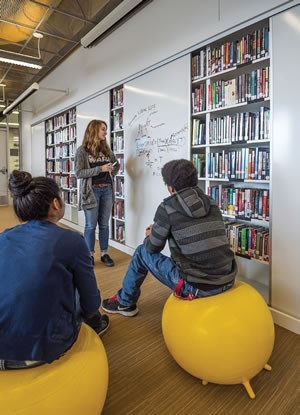
PHOTO © KEN GRAHAM PHOTOGRAPHY
Lecture versus hands-on exercises. Static desks versus swivel chairs and Hokkie Stools. Industrial Age versus 21st Century design. What does your high school look like? And how engaged are your students?
School districts around the globe face challenges every day — not just to keep kids in school, but also to keep their attention for eight or more hours at a time. Years of experience serving school districts and local communities have shown me this is no easy task. Throughout my design career, my observations have led me to conclude today’s students need a different environment to remain engaged and excited about learning. They want more than previous generations, and are leading an evolution that’s changing the way we design schools. School districts in turn are taking notice, and are now seeking “proof” that these new school designs have a positive impact on learning.
Early research from pioneering Environment-Behavior Psychologists like Robert Sommer (1969) and Edward T. Hall (1966) determined that the built environment impacts human behavior. Their work spawned a continuous study of the interaction between humans and the places in which they live and work. Newer interests for researchers focus on where people learn; as an educational designer, I am particularly interested in this research. Clients ask us for this type of information every day. They want to understand what effect our designs have on a student’s learning experience, as Jonathon Guthrie, principal of Bentonville West High School (BWHS) explains.
“I am interested to see the link between building design and student engagement. At BWHS, we are always looking for ways to engage students. If our building design enhances engagement, that’s a plus for everyone,” said Guthrie.
DLR Group’s Global K-12 Education Studio has a responsibility to provide school district clients with the proof they want — evidence that innovative design solutions work to advance learning spaces and contribute to student success. To that end, our firm has embarked on a journey of exploration to help us better understand the true impact of the buildings we design.
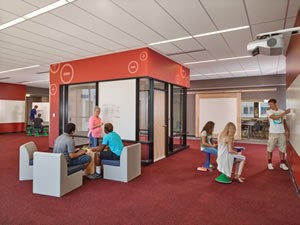
PHOTO © ALISTAIR TUTTON PHOTOGRAPHY
Student Engagement Index
Partnering with consultant Dr. Lennie Scott-Webber of INSYNC: Education Research + Design, DLR Group began developing our research strategy and agenda. According to findings from the 2013 National Survey of Student Engagement, student engagement is a high predictor of academic, social, emotional, and behavioral success, which is why our first step was to create a Student Engagement Index (SEI) survey that could measure indexes for both students and educators. The SEI posits this research question: “Can we demonstrate a connection between the design of the physical environment of a school building and student academic engagement?” Our ultimate goal was to generate empirical evidence to embed into future design solutions.
“Some of us have been researching the design of education environments for many years, but this field of research is still very young. Empirical, or primary research is very important to the academic community. Proof goes a long way in supporting critical decision-making when clients are asked to trust their architectural design leads,” said Scott-Webber, explaining the importance of collecting and analyzing this kind of data.
The Alpha Test
We completed an Alpha pilot of the SEI survey and data analysis in March 2017. The convenience sample consisted of one 9-12 grade high school in the central Midwest, where we collected 102 usable student and 77 usable educator surveys. Multiple statistical analysis techniques determined reliability, validity, and findings. The survey questions were divided into two categories to reflect the distinct areas in question: overall, referring to the macro environment, and classroom, referring to the micro environment.
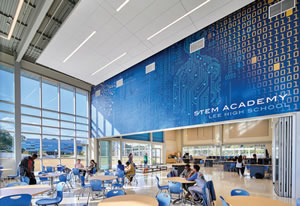
PHOTO © MICHAEL ROBINSON PHOTOGRAPHY
Two surveys were administered to educator and student user groups. Two base-line questions addressed pedagogy and location. Pedagogy refers to the amount of lecturing versus alternate teaching practices such as small group work, hands-on activities, and team projects, while location refers to where teaching took place. We wanted to know whether educators were using building features designed for alternate teaching methods, an approach believed to promote student engagement. Some of these “beyond the classroom” features included breakout/collaborative spaces, open cafeteria/meeting areas, and outdoor learning spaces. Responses from both students and educators showed the perceived dominant teaching method was lecture conducted almost exclusively in the classroom.
A few sample questions include:
Micro Environment: For you to be deeply engaged in your learning in the classroom, how important is it for you to…
- Transition in and out of small group work and other teaching practices?
- Move about to learn?
- Experience hands-on learning?
- Use vertical wall space to work on projects?
- Experience projects that are “real world”?
- Choose different parts of the room to connect with peers?
- Take part in collaborative learning projects?
- Have my brain challenged?
Macro Environment: Now, think about the design of the building OVERALL. How would you rate your school building’s design OVERALL on the following design attributes?
- Noise level
- Lighting level
- Temperature comfort
- Access to natural lighting
- Feeling safe
- Comfortable furnishings
- Inviting spaces
- Air flow
Respondents used a ranking system to answer from “not at all” to “essential” on the micro environment question shown above, and “poor” to “excellent” on the macro environment question.
Initial findings from the Alpha study are significant/positive. In research terms, both students and faculty agree that the design of their built space positively impacts academic engagement levels.
“What’s important to understand here is that both students and educators agree that the design of the physical space in which they learn and teach makes a difference in terms of how engaged students become. Space matters,” said Scott-Webber.
Students who reported an abundance of lecture-style teaching felt less impact from the environment on their ability to move around and engage deeply in their learning. Alternatively, students who believed the design of the physical environment impacts their ability to move around and engage deeply in their learning reported experiencing less lecturestyle teaching. These students were also more likely to believe that hands-on learning and the ability to move about are important for them to actively engage in learning.
“I hope the data is used to promote effective and productive educational structures that encourage high levels of student engagement and learning,” said Dr. Timothy Mitchell, superintendent of Riverside Community School District. “We know that a positive climate can have a real impact on our teachers and students. This in turn helps raise the level of student achievement and future success.”
Progressing to the Beta Phase and Beyond
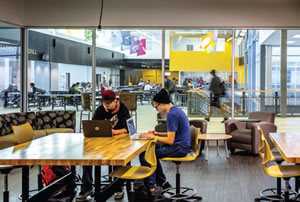
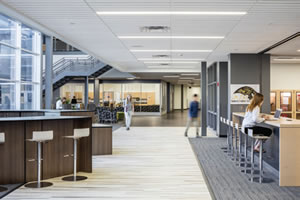
PHOTOS © BRANDON STENGEL PHOTOGRAPHY
Design and academic engagement. Results of a survey, conducted in partnership by DLR Group and consultant Dr. Lennie Scott-Webber of INSYNC: Education Research + Design, indicate that flexibility in the design of curriculum, longer scheduling periods, and pedagogical practices that “ use space as a tool” are critical factors for successful academic engagement levels of students.
As a continuation of the study, DLR Group issued a Beta study with additional convenience samplings of four 9-12 grade high schools across the country. We collected data through May 2017 and are in the process of analyzing each school, then aggregating the data across all schools.
The Beta analysis will provide further evidence of the strength of the SEI© as a tool to help predict the correlation between student engagement and design. We’re hoping to uncover more proof that good design, one that is intentional and supports the needs of human behaviors in educational settings, leads to high levels of engagement. Once the Beta results are validated, the final step in the process is to roll out the Omega, or final survey, for use by DLR Group’s K-12 Education Studio for many years.
“Participation in a study like this gives us data to use when designing new schools and renovating old ones. In addition, we may learn some things that will inform our instructional choices,” said Guthrie. “If the student data shows a clear engagement preference for a design element, we will try to implement more of that element in our future designs.”
School districts are not the only benefactor of this research — communities at large can benefit from the positive impacts of design on education, as Mitchell explains.
“During the process to gain support for our project, many promises were made to the public about how the new building would promote student success, including how several design features would help us deliver instruction in a variety of ways not available in our current older building. Having the data to share with our public is a way to be accountable,” said Mitchell. “The community made a tremendous investment in our students and we want them to feel that their support was of value to our students and our community.”
Looking to the Future
Initial findings represented one convenience sample, but the fact that preliminary Beta tests are returning similar results suggests that flexibility in the design of curriculum, longer scheduling periods, and pedagogical practices that ‘use space as a tool’ are critical factors for successful academic engagement levels of students.
Our research findings are validating our anecdotal beliefs. What our research is providing DLR Group is a deeper understanding of the impact our designs have on the success of both students and teachers. We now have evidence which will continue to grow, allowing us to shape the next generation of advanced learning spaces. The bottom line is, when working to achieve a deep level of student engagement, the design of space matters.
This article originally appeared in the issue of .
About the Author
Jim French is the leader of DLR Group’s Educational Forum, a nationwide representation of the firm’s foremost planners and designers dedicated to K-12 education. Jim has more than 20 years of exclusive educational planning experience and has led the design and construction of over $1 billion in educational facilities. He has a thorough understanding of K-12 learning concepts, and as a senior member of the firm’s national design team, he routinely leads interactive charrette sessions with communities and districts across the country. His award winning designs create some of the most flexible and adaptable facilities in the country. Jim’s ability to seamlessly create facilities that work educationally as well as aesthetically has been a trademark of his design success.